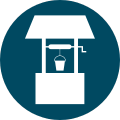
Our vision:
A safe and healthy Kitsap County for all.
Septic System Construction, Repairs & Maintenance
Drinking Water & Onsite Sewage
Read below for steps on how to maintain, repair, and install a septic system.
Questions? We are here to help! Call us at 360-728-2235.
What You Need to Know About Properties Connected to a Septic System
A septic system is a critical part of a home. It collects, treats, and disposes of all water from toilets, sinks, tubs, showers, dishwashers, and other appliances.
Before buying or selling a home connected to a septic tank, make sure that you know the status of the septic system. Kitsap Public Health District can review records, inspect the system, and provide you with a written report of what we find. This is a great way to help protect your investment and follow regulations (Kitsap Public Health Board Ordinance 2025A-01, Section 13.D).
Before the final sale of a property, contact us for a property conveyance inspection (PCI) to identify any significant problems. Without an inspection, potential problems are not corrected and can cause major problems later on. For instance, a septic system my fail after new owners purchase a home, costing them thousands of additional dollars in repairs.
For us to perform a property conveyance inspection, we will need a record drawing. If your property does not have one, you will need to create one.
2024 Property Conveyance Inspection Findings
1,676 property conveyance inspections for septic were completed in 2024. Of those, 464 (28%) had significant deficiencies identified.
Avoiding Common Problems on Property Conveyance Inspections


Encroachment
Don’t build or park on your primary or reserve drainfield. Primary and reserve drainfield areas are intended to be maintained clear for maintenance and for future use.
Maintenance accessibility
For alternative systems, keep components accessible for maintenance.
Using beyond capacity or having unpermitted connections
Stay within the designed capacity of your drainfield design. To find out how many bedrooms your septic is approved for, search for your records through our GIS Search.
Do not add plumbing to outbuildings without project review and approval from Kitsap Health.
Compromised primary or reserve areas
Know where your septic areas are and protect them. To learn more about protecting those areas, review the Homeowner’s Guide
What You Need To Know About Properties Connected to a 1- or 2-party well or a Group B Water System
Effective March 4, 2019, all properties served by a Private or Group B Water System are required to have a Water Status Report from the Health District bfore they are sold.
Water Status Report applications (public and private) should be submitted 30 days before the property transfer to allow for any identified issues to be addressed before closing sale.
For more information, read our Private Water Status Report Frequently Asked Questions handout.
Just like a property conveyance inspection is important to know the status of a septic system, it is also important to evaluate your water system to identify significant problems.
2024 Private Water Status Report Findings
438 private water status reports were completed in 2024. Of those reports, 173 (39%) had significant problems identified.
Avoiding Common Problems on Private Water Status Reports
Construction Standards
Keep your well-head above grade and accessible (at least six inches above grade)


Well openings/access for contamination
Openings in the well casing/cap can allow contamination into the well. Ensure conduit, cap and all other entry points are sealed.
Ensure pressure tank maintenance is up to date and sample for bacteria annually. For more information about bacteria sampling, view our handout.

2024 Group B Water Status Report Findings
124 public water status reports for Group B systems were completed in 2024. Of those, 106 (84%) significant problems were identified.
Avoiding Common Problems on Public Water Status Reports
No user agreement
Group B user agreements have been required since 2019. All water systems should review their current user agreement or, if there isn’t one, create one. Learn more:
No operating permit
Group B water systems must have a current operating permit. Ensure water system contact information is up to date and the permits have been paid. For more information, visit our Group B Public Water Systems page.
No current samples
Most Group B water systems must sample annually for bacteria and every three years for nitrate. If you’re unsure of your sampling frequency or need technical assistance with taking samples, please call us at 360-728-2235 and ask to speak to the Drinking Water Inspector of the Day.
Reminder cards are mailed approximately 30 days prior to sample due date. Please make sure your system contact information is up to date.
How do I maintain my septic system?
A lot of people don't think about their septic system until it stops working. Think about septic system maintenance the same way you maintain your car: it needs regular inspections and maintenance to run properly and last as long as possible.
Keeping your septic system maintained helps keep you, your community, and the environment healthy. Follow the tips below to keep your septic working and help save thousands of dollars in repairs.
Gravity Septic System Maintenance
Have your system inspected every three years by a septic service professional certified by the Kitsap Public Health District.
These inspections help make sure you system is working the way it should and can let you know if you need your septic tank pumped. Inspections also help:
Protect ground, surface and drinking water from contamination
Prevent bacteria from entering Puget Sound
Prevent expensive repairs
Have questions or need help? Give us a call at 360-728-2235!
You can also print our Septic System Safety fact sheet.
Alternative Septic System Maintenance
Some septic systems are more complicated and require at least one inspection a year (or more). If your system is "alternative" (has pumps, treatment devices, or other parts different from a typical gravity system) and is not inspected regularly it is more likely to fail and cost thousands of dollars to fix. If you own an alternative system, you must have an annual maintenance contract with a certified monitoring and maintenance specialist.
Learn more about different types of septic system and maintenance needs in our Homeowner's Guide.
How do I repair my septic system?
A failing septic system can be very stressful.
Small Repairs
Small repairs can be handled by the property owner or a certified septic maintenance worker. For these types of repairs, read our Minor Repair Policy.
If You Need a New Drainfield
A licensed septic designer is hired to prepare and submit a Building Site Application (BSA). The BSA proposes the size, type, and location of the septic system.
After the BSA is reviewed and approved by the Health District, the applicant works with a certified septic installer, working with the septic designer, to acquire a septic installation permit and installs the system according to the approved design.
A Health District employee will inspect the system before it's covered up. After the inspection, the new system can be placed for operation.
Septic repair or replacement loans
Septic system repair or replacement can be financially overwhelming. Check out these resources for possible loans and grants:
How do I design and install a new septic system?
If you want to build and install a new septic system:
Hire a licensed septic designer to submit a Building Site Application (BSA). The BSA proposes the size, type, and location of the septic system. It also includes information about the proposed drinking water supply for the property and any buildings that are proposed.
After the BSA is reviewed and approved by the Health District, the applicant acquires a building permit from the appropriate building department for the property.
After the building permit is issued, a certified septic installer, working in conjunction with the septic designer, applies for a septic installation permit and installs the system according to the approved design.
Once the new system is approved, the applicant gets permission from the building department for occupancy of the new structure.
If you want to build on a property with an existing septic system:
The owner or contractor will submit a Building Clearance (BC) application. The BC shares the proposed project and whether a new connection to the existing septic system will be needed. If a connection permit will be required, it must be applied for at the time of the BC application.
After the BC is reviewed and approved by the Health District, the applicant acquires a building permit from the appropriate building department for the property.
A certified septic installer or the homeowner then makes the new connection to the system according to the approved application.
Once the new connection is approved, the applicant gets permission from the building department to use the structure.
Septic safety tips
Walk your property routinely to observe and address potential safety and health risks.
Check the drainfield and down slope areas for broken equipment, holes, odors, wet spots, or surfacing sewage. Exposure to bacteria can cause a health risk to people, pets, and the environment.
Make sure your septic tank lid is secure.
Check for damage and cracks and make sure the lid is securely fastened to prevent injuries and falling into the tank. Lids can become brittle from the sun and weather and should be replaced if damaged.
Instruct children not to play near septic systems.
Kids are naturally curious and love to explore the outdoors. But playing around the septic tank or trying to open the lid can be dangerous. Kids or pets can be seriously injured or get very sick from falling into or around a septic tank.
Know where your septic system is located
If you're not sure where your septic system and drainfield are, contact us at 360-728-2235 or search online for your property’s record drawing. Knowing this information is important so you can avoid things like:
Children and pets from playing near the system
Putting new structures on the drainfield
Cars and heavy equipment parked on your drainfield
Drainfield landscape tips
Choosing the right plants and landscaping design over your drainfield can help protect it. Choose low-maintenance plants that require small amounts of water and have shallow roots.
Learn more landscaping tips in our guide or by contacting Kitsap County's Master Gardener program at 360-228-7320.










.png)
